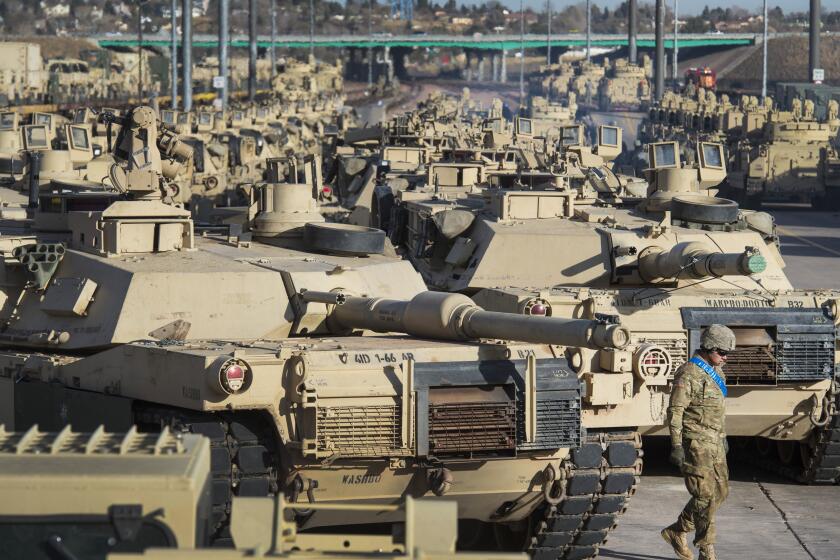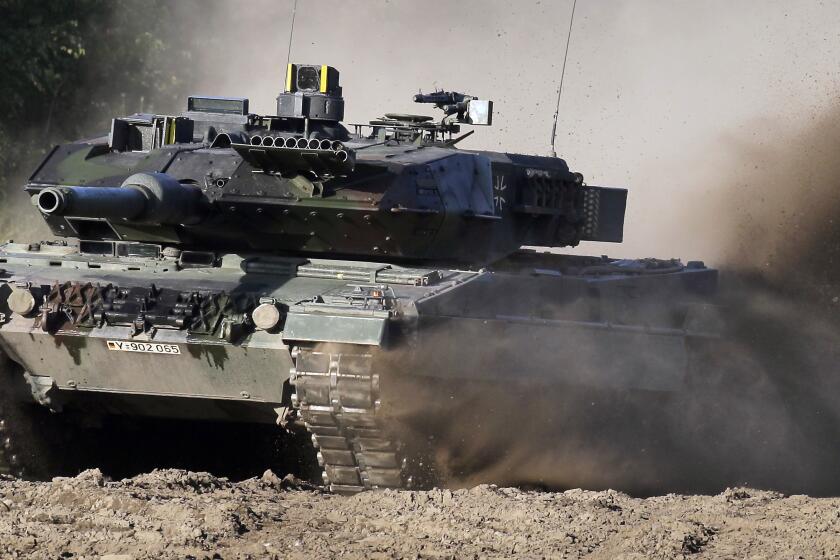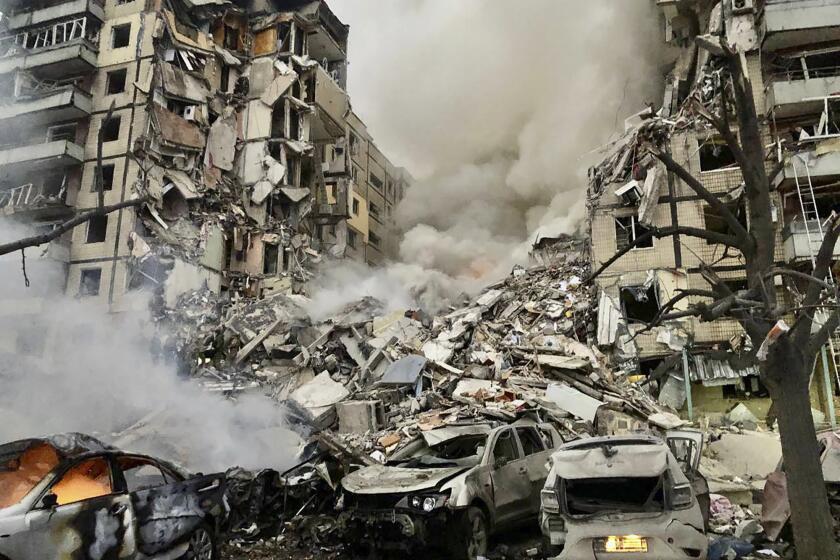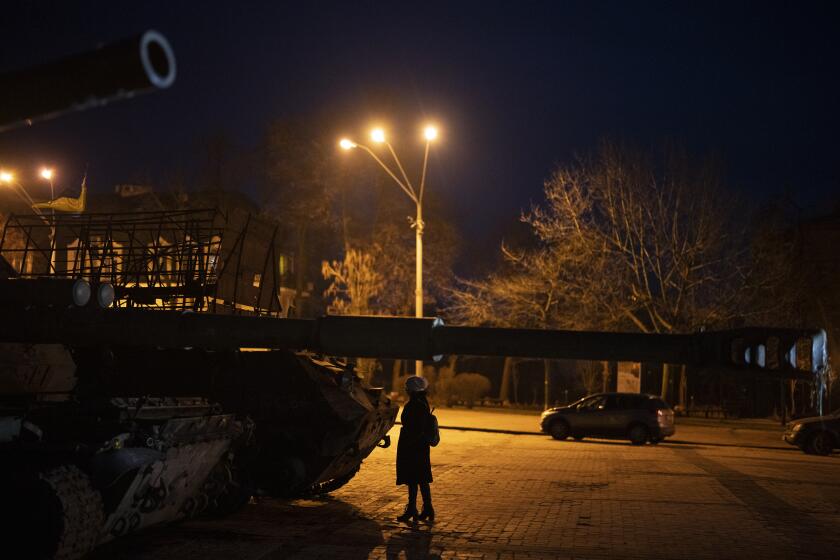U.S. and Germany will send battle tanks to Ukraine

Germany and the U.S. will send tanks to Ukraine in an effort to help Kyiv break battlefield stalemates as the war with Russia enters its 12th month.
- Share via
WASHINGTON — President Biden announced Wednesday that the U.S. will send 31 M1 Abrams battle tanks to Ukraine, reversing months of persistent arguments that the tanks were too difficult for Ukrainian troops to operate and maintain.
The U.S. decision came on the heels of Germany agreeing to send 14 Leopard2 A6 tanks from its own stocks. Germany had said the Leopards would not be sent unless the U.S. put its Abrams on the table, not wanting to incur Russia’s wrath without the U.S. similarly committing its own tanks.
“This is the result of intensive consultations, once again, with our allies and international partners,” German Chancellor Olaf Scholz told German lawmakers. “It was right, and it is important that we didn’t let ourselves be driven” into the decision.
Biden said that European allies have agreed to send enough tanks to equip two Ukrainian tank battalions, or a total of about 62 tanks.
“With spring approaching, Ukrainian forces are working to defend the territory they hold and preparing for additional counteroffenses,” Biden said in his announcement of his decision to send the tanks. “To liberate their land, they need to be able to counter Russia’s evolving tactics and strategy on the battlefield in the very near term.”
The Biden administration is planning to announce a decision to send M1 Abrams tanks to Ukraine to help its defense against Russia, officials said Tuesday.
The announcement ends a standoff between Germany and the United States. Biden administration officials on Wednesday sought to downplay any friction between the two allies as both unveiled their plans.
Both sides had participated in “good diplomatic conversations” that had made the difference and were part of the “extraordinary shift in Germany’s security policy” over providing weapons to Ukraine since Russia invaded in February, said a senior administration official who briefed reporters Wednesday on condition of anonymity to describe the new tank package before the announcement.
The $400-million package announced Wednesday also includes eight M88 recovery vehicles — tank-like tracked vehicles that can tow an Abrams if it’s stuck.
Altogether, France, the U.K., the U.S., Poland, Germany, the Netherlands and Sweden will send hundreds of tanks and heavy armored vehicles to fortify Ukraine as it enters a new phase of the war and attempts to break through entrenched Russian lines.
The U.S. tanks will be purchased through the Ukraine Security Assistance Initiative, which means it will take some time for the Ukrainian forces to receive the tanks and be able to deploy them on the battlefield. The Pentagon plans soon to begin training Ukrainian forces on the system outside Ukraine.
Germany may soon approve deliveries of high-tech Leopard 2 tanks that Ukraine and others hope will boost Kyiv’s fight against Russian invaders.
The U.S. has thousands of Abrams in stock. Still, it does not have “excess stock,” said White House National Security Council spokesman John F. Kirby. He said Ukraine’s military will have to go through significant preparation to learn to operate, maintain and sustain the Abrams. It’s a process that will take some months.
Using the assistance initiative funding route, instead of dipping into the existing U.S. stockpile, means it is unlikely the tanks will be available to Ukraine before Russia’s anticipated spring offensive.
Kirby declined to pinpoint when the Abrams will be delivered but said the German-made Leopards are expected to make their way to Ukrainian forces more quickly. The deployment also suggests that the U.S. and its allies are girding to support Ukraine for a long war that shows no signs of coming to an end.
Doug Bush, assistant secretary of the Army for acquisition, said the U.S. stock includes both the older variants and newer M1A2 Abrams variants, and when a “new” tank is needed, it starts with an older hull.
“We don’t produce any tanks from scratch anymore,” Bush said. “We have a large stock of older M1s that we use as seed vehicles. Were we to ever run out of those, sure we would build new. But right now, no matter which option we go, we don’t have to build completely new.”
U.K. prime minister promises to provide tanks and artillery systems to Ukraine amid renewed missile attacks by Moscow targeting Ukrainian cities.
The Russian ambassador to Germany, Sergey Nechayev, called Berlin’s decision to send Leopard 2 tanks to Ukraine “extremely dangerous” and said it “shifts the conflict to a new level of confrontation.”
Biden said Russia should not view the decision to provide the tanks as an escalation in the war.
“It is not an offensive threat to Russia,” Biden said. “There is no offensive threat to Russia. If Russian troops return to Russia, where they belong, this war would be over today.”
Ukrainian President Volodymyr Zelensky applauded Biden for the “powerful decision to provide Abrams,” declaring on Twitter that “the free world is united as never before” in the 11-month-old war.
Until now, the U.S. had resisted providing its M1 Abrams tanks to Ukraine, citing extensive and complex maintenance and logistical challenges with the high-tech vehicles. Washington believes it will be more productive to send the German Leopards since many allies have them and Ukrainian troops will need less training than on the more difficult Abrams.
Daniel W. Swift, a former member of the Navy SEALs, was killed Wednesday in Ukraine, U.S. officials said Friday. They said he was not fighting in an official capacity.
Biden in an exchange with reporters bristled at the notion that Germany, which had declined to provide tanks until the U.S. agreed to provide its Abrams, forced his hand.
“Germany didn’t force me to change [my] mind,” Biden said. “We wanted to make sure we were all together.”
For the Abrams to be effective in Ukraine, its forces will require extensive training on combined arms maneuver — how the tanks operate together on the battlefield — and on how to maintain and support the complex, 70-ton weapon. The Abrams tanks use a turbine jet engine that burns through fuel whether moving or idling — at least two gallons a mile when on the move — which means that a network of fuel trucks is needed to keep the line moving.
“When they get there, we want to make sure that they fall on ready hands, and that the Ukrainians know how to use them, they know how to keep them running, and they’ve got the supply chain in place for spare parts and supplies, and anything else they need so that they can be more effective on the battlefield,” Kirby said.
More to Read
Sign up for Essential California
The most important California stories and recommendations in your inbox every morning.
You may occasionally receive promotional content from the Los Angeles Times.













